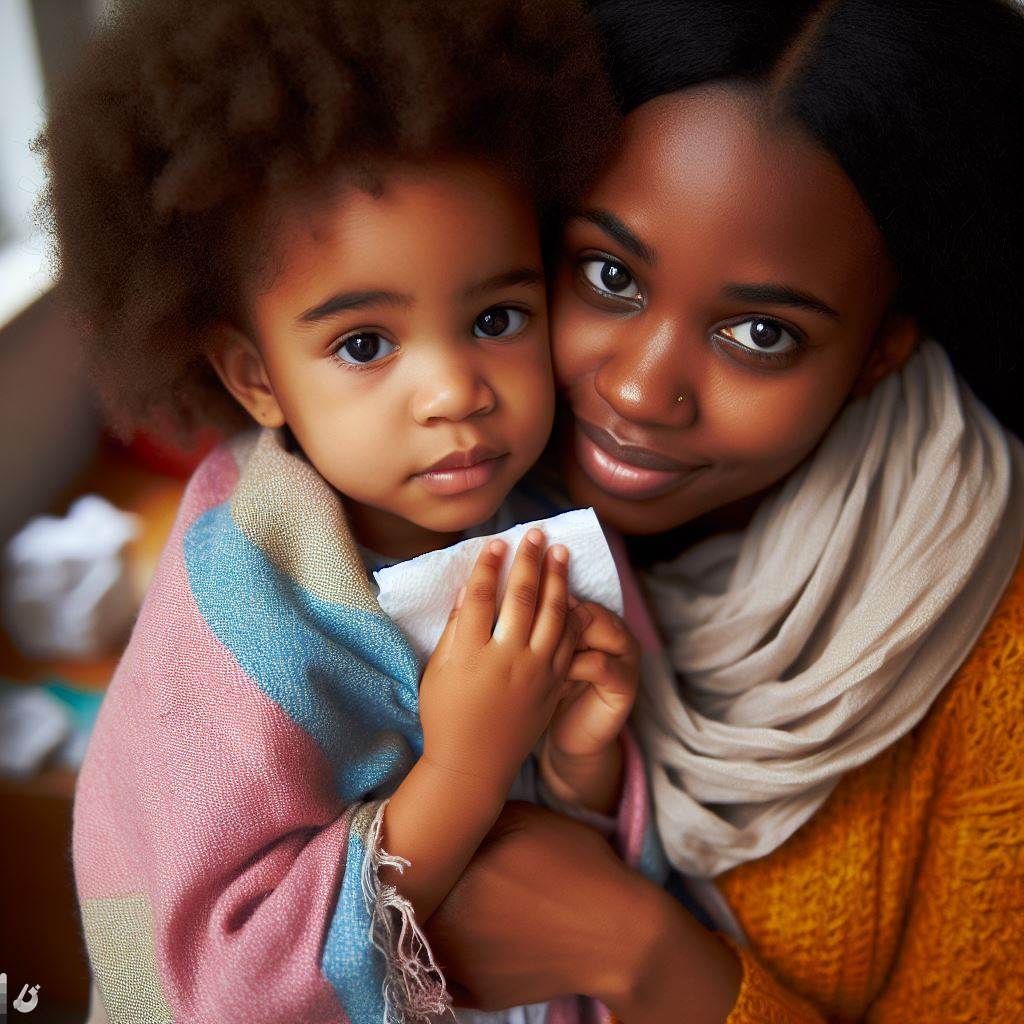Introduction
Importance of Safe Baby Bathing
Bathing a newborn or infant is a precious bonding time for parents in Nigeria.
Proper bathing techniques are crucial to ensure the baby’s safety and well-being.
This post aims to provide concise yet effective guidance for Nigerian families on safe baby bathing practices.
Brief Overview of Techniques for Nigerian Families
Nigerian families often face challenges due to diverse environmental factors.
The techniques discussed here consider these challenges and offer practical solutions.
From ensuring the water temperature is warm but not hot to using gentle cleansers suitable for the baby’s sensitive skin, each aspect is crucial for a safe bathing experience.
The blog section focuses on active techniques that facilitate safe bathing for Nigerian families.
By utilizing easily accessible items like a plastic tub, clean towels, and mild baby soap, caregivers can enhance safety during the bathing process.
Additionally, guidance on proper support while holding the baby in the water and methods to gently clean specific areas of the body will be discussed in detail.
This post will explore tips on maintaining hygiene during baby bathing, emphasizing the importance of cleanliness while handling newborns or infants.
Furthermore, the blog will shed light on practical methods for drying and dressing the baby post-bath, ensuring comfort and protection from temperature fluctuations.
Nigerian families often rely on traditional remedies and practices. This section aims to blend traditional approaches with modern techniques for a holistic view.
By combining cultural knowledge with evidence-based practices, families can create a safe and enjoyable bathing experience for their little ones.
In essence, this post will provide actionable steps and insights tailored to Nigerian families, empowering them to embrace safe baby bathing practices with confidence and ease.
Preparing for a Safe Baby Bath
Preparing for a baby bath is an important task that requires careful organization and attention to details.
Parenting Made Just for You
Get personalized Parenting Solutions tailored to your child’s needs. Transform your parenting journey with expert guidance in 1-3 days.
Get StartedBy gathering all the necessary bath supplies in advance, you can ensure a smooth and safe bathing experience for your little one.
Gather necessary bath supplies
Firstly, make sure to have baby soap or a gentle liquid cleanser at hand.
Babies have delicate skin that is susceptible to irritations, so choosing a mild and hypoallergenic cleanser is essential.
Alongside this, prepare a soft washcloth to cleanse their tiny bodies gently.
Moreover, baby shampoo is necessary to keep their hair clean and healthy.
Opt for a tear-free formula specifically designed for babies, as it is gentle on their eyes and skin.
After bathing, wrap your baby in a fresh, clean towel to dry them off comfortably. Always have a clean diaper and clothes nearby for the post-bath routine.
Maintain a comfortable bath environment
Creating a comfortable bath environment is vital to ensure a positive bathing experience for both you and your baby.
Start by adjusting the water temperature to the optimal level.
Test the water with your elbow or a thermometer to ensure it is warm and not too hot for your baby’s delicate skin.
Additionally, make sure the bathroom has adequate lighting and ventilation.
Sufficient lighting will help you see clearly while bathing your baby, preventing accidents or mishaps.
Ventilation will ensure proper air circulation, helping to keep the bathroom environment fresh and comfortable.
Lastly, it is crucial to secure the bathing area to prevent any accidents or slips.
Unveil the Perfect Name that Tells Your Family's Story
Let us help you find a name that embodies your family's values, traditions, and dreams. Our personalized consultation weaves cultural insights to create a name that's uniquely yours.
Get StartedUse non-slip mats or adhesive strips in the bathtub to provide a stable surface for your baby.
Always keep a firm grip on your little one during the bath to ensure their safety.
Wash your hands thoroughly before handling the baby
Before handling your baby, it is essential to wash your hands thoroughly.
Babies have fragile immune systems, and proper hand hygiene reduces the risk of infections.
Use warm water and soap, lathering your hands for at least 20 seconds before rinsing them off completely.
This simple yet effective step protects your baby from harmful germs.
In fact, preparing for a safe baby bath involves gathering the necessary bath supplies, maintaining a comfortable environment, and prioritizing hand hygiene.
By following these steps, you can ensure that bath time becomes a soothing and enjoyable experience for both you and your baby.
Read: Infant Sleep Safety: Must-Knows for Nigerian Parents
Identifying the Suitable Bathing Method Based on the Baby’s Age
Sponge bath for newborns (0-4 weeks)
Gather supplies needed: warm water, baby soap, clean towels, washcloths, diaper, and clean clothes.
Here is a step-by-step guide for sponge bathing a newborn:
- Fill a basin or sink with warm water (around 37 degrees Celsius).
- Undress the baby, leaving only the diaper on.
- Hold the baby securely and gently wash their face with a soaked washcloth, carefully wiping the eyes, nose, and ears.
- Dip a clean washcloth into the warm water, add some baby soap, and clean the baby’s neck, arms, hands, and chest.
- Lift the baby’s legs and clean their genital area with a mild soap, keeping a gentle touch.
- Rinse the soap off with a clean, wet washcloth.
- Use a towel to pat the baby dry, making sure to dry all the creases and folds.
- Put a clean diaper on the baby and dress them in fresh clothes.
Supported sitting position for babies (4 weeks – 6 months)
Gather supplies needed: baby bathtub, warm water, mild baby soap, towels, washcloths, and clean clothes.
Here is a step-by-step guide for bathing a baby in a supported sitting position:
- Fill the baby bathtub with warm water, ensuring that the water level is safe and comfortable for the baby.
- Place the baby in the bathtub, ensuring they are seated securely with support.
- Wet a washcloth and gently wash the baby’s face, cleaning their eyes, nose, and ears.
- Use a baby soap to clean the baby’s neck, arms, hands, chest, and genital area, being extra careful around sensitive areas.
- Rinse off the soap with clean water using a cup or a washcloth.
- Lift the baby out of the bathtub and wrap them in a dry towel, patting them gently to dry their skin.
- Put a clean diaper on the baby and dress them in fresh clothes.
Transition to a baby bathtub for older infants (6 months and beyond)
Choose a suitable baby bathtub that provides enough support and comfort for the baby.
Here is a step-by-step guide for using a baby bathtub:
- Set up the baby bathtub in a safe and stable location, ensuring it is filled with warm water.
- Gently place the baby in the bathtub, ensuring they are seated comfortably and securely.
- Use a washcloth and mild baby soap to clean the baby’s face, body, and genital area, paying attention to any creases or folds.
- Rinse off the soap thoroughly using clean water, either with a cup or a handheld showerhead if available.
- Lift the baby out of the bathtub and wrap them in a dry towel, gently patting them dry.
- Dress the baby in clean clothes and ensure they are kept warm and comfortable after the bath.
In short, by identifying the suitable bathing method based on the baby’s age, Nigerian families can ensure the safety and comfort of their little ones during bath time.
Whether it’s a sponge bath for newborns, a supported sitting position for babies, or transitioning to a baby bathtub for older infants, following the proper techniques is essential for a positive bathing experience.
Read: Finding Reliable Childcare in Nigeria

Ensuring a safe bathing process
Maintaining the safety of your baby during bath time is of utmost importance.
By following these guidelines, you can ensure a safe bathing process for your little one.
Maintain constant supervision
Never leave your baby unattended in the bathtub, even for a moment.
Accidents can happen in an instant, and it is crucial to keep a watchful eye on your child at all times.
Remember, even a small amount of water can pose a drowning risk for infants.
Additionally, it is essential to keep one hand on the baby while they are in the water.
This constant physical contact provides an extra layer of security and helps prevent accidents.
Handling and supporting the baby properly
When bathing your baby, it is vital to use gentle and secure hold techniques. Cradle their body in your arms, ensuring their head and neck are properly supported.
This helps prevent any strain or injury to their delicate muscles and bones.
Babies can be slippery when wet, so exercise caution while handling them. Use a non-slip mat or surface to prevent any accidents due to slipping.
Additionally, keeping a firm grip on your baby will help avoid any mishaps.
Avoiding common hazards
To prevent water burns or scalds, always check the water temperature before placing your baby in the bath.
It should be warm but not too hot. Use your elbow or the inside of your wrist to test the water.
Protect your baby from accidental falls by using a baby bath seat or a non-slip bath support.
These aids provide stability and reduce the risk of your baby slipping or tipping over in the tub.
Be mindful of the potential risks of water inhalation or drowning. Babies can drown in even a few inches of water, so never leave them alone.
Avoid distractions and focus solely on your baby’s safety during bath time.
While bath toys can be entertaining, they can also pose hazards. Be cautious with toys that have small parts or can be easily swallowed.
Regularly inspect the toys for any signs of damage or mold, and replace them if necessary.
By following these guidelines, you can create a safe bathing environment for your baby.
Remember, bath time should be a peaceful and enjoyable experience for both you and your child, free from any potential dangers.
Read: Baby-Proofing 101: A Nigerian Parent’s Guide
After-bath care and hygiene practices
Drying and dressing the baby safely
- Always use a soft towel and gently pat dry the baby’s skin to avoid irritation.
- After drying, apply appropriate moisturizers or lotions to keep the baby’s skin nourished and hydrated.
- Ensure that the baby is dressed in clean clothes and put on a fresh diaper.
Maintaining proper hygiene of bath supplies
- After each use, make sure to clean and dry all the bath equipment, such as tubs, buckets, and sponges, to prevent bacteria growth.
- Regularly replace any worn-out or damaged bath supplies to ensure they remain safe and hygienic for the baby’s use.
Establishing a routine for regular bathing
Creating a consistent bathing schedule for the baby offers both comfort and cleanliness benefits:
- Stick to a specific time of day for bathing, such as before bedtime or after morning wake-up.
- Ensure the water temperature is appropriate for the baby’s delicate skin, not too hot or cold.
- Have all necessary bath supplies within reach to avoid leaving the baby unattended during bathing.
- Use gentle baby-friendly cleansing products formulated for sensitive skin.
- During bath time, engage in interactive activities with the baby to make the experience enjoyable and relaxing.
By following these after-bath care and hygiene practices, Nigerian families can ensure their baby’s safety and well-being.
Properly drying and dressing the baby, maintaining clean bath supplies, and establishing a bathing routine are essential steps in providing a hygienic environment for the baby’s overall health.
Read: Navigating Maternity Leave in Nigeria
Conclusion
Safe baby bathing is of utmost importance for Nigerian families.
It cannot be stressed enough how crucial it is to ensure the safety and well-being of our little ones during bath time.
We must remember that accidents can happen in an instant, and it is our responsibility to minimize any potential risks.
By taking the necessary precautions and following proper techniques, we can create a safe and enjoyable bathing experience for our babies.
As Nigerian families, we need to prioritize our baby’s safety during baths.
This means always keeping a close eye on them, never leaving them unattended, and using baby-friendly products and equipment.
Lastly, here are a few final tips and recommendations for a safe baby bathing experience:
- Ensure the water temperature is lukewarm by using a thermometer or testing it with your elbow.
- Keep all bathing essentials (such as shampoo, soap, towels, and diapers) within arm’s reach.
- Place a non-slip mat in the bathtub or on the bathroom floor to prevent accidents caused by slipping.
- Support your baby’s head and neck while bathing, especially for newborns and infants.
- Gently dry your baby with a soft towel and moisturize their skin to prevent dryness or irritation.
Remember, the safety and well-being of our babies should always be our top priority.
Let us make every bath time a safe and enjoyable experience for our little ones.
Thank you for reading this section on safe baby bathing techniques for Nigerian families. Stay safe!




